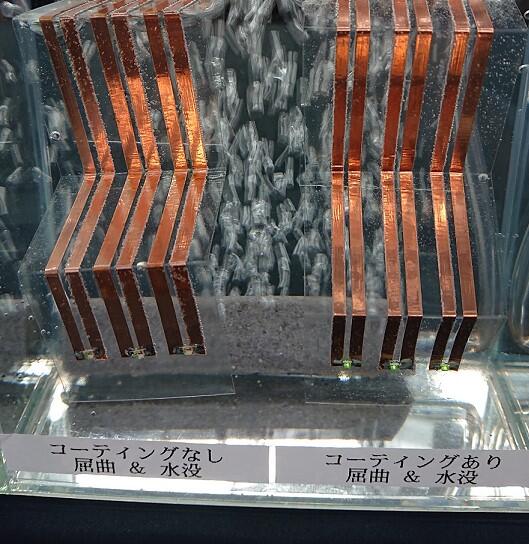If electronic circuits get dampened with water, they end up short-circuiting and breaking even if it is deionized water that does not conduct electricity. This is mainly the result of a phenomenon known as ion migration. Metal ions leak out of the circuit's positive electrode and are dendritically deposited on the negative electrode, thus connecting the circuit. As a result, even if the circuit is dried, electricity ends up being conducted and the circuit does not return to how it was. Furthermore, because the metal that has been dendritically separated is extremely fine, it can also cause unexpected accidents as a result of heat being generated. In light of this, in smartphones and other devices the surfaces of electronic circuits are sealed by coating them with resin, to prevent intrusions of water.

A research group comprising doctoral course student and Japan Society for the Promotion of Science (JSPS) Research Fellow Takaaki Kasuga, Professor Masaya Nogi and others at the Institute of Scientific and Industrial Research, Osaka University, discovered that it is possible to achieve long-term suppression of water-exposure damage to electronic circuits simply by coating them with wood-derived nanofibers. The research group's findings were published in ACS Applied Nanomaterials.
Up to now the research group had been pursuing goals such as the development of a biodegradable sensor device that uses transparent paper produced from nanofibers (nanopaper). Now, they have coated the surface of circuits using an extremely simple method - namely, dissolving a nanopaper containing a high carboxyl content in water and then drying it on the surface. As a result, even if the circuits are dampened with water, ion migration does not occur.
Detailed analysis has revealed that nanofibers dissolved in negatively-charged water gather at the positive electrode and form a gel, trapping the electrode's metal ions that have begun to dissolve in the water. Because the metal ions do not migrate, the metal is not dendritically deposited on the negative electrode.
When the research group carried out experiments with metals such as copper and silver, which are commonly used in electronic circuits, it found that in all cases the same method protected the positive electrode and averted short circuits. Kasuga explains that "Even when electricity was passed through the circuits while they were wet, no problems whatsoever were detected. In the experiments, the circuits remained okay even when we ran electricity through them for three days."
Because this coating forms a gel, it does not break when bent like existing resins do.
Kasuga says that "I believe it may be possible to use the coating as a final defense by placing it under the resin. Because nanofibers and nanopapers absorb water easily, it was frequently suggested to us that they were not suited for use with electronic devices. However, for the very reason that they absorb and re-disperse water as they did in this case, they also harbor new functions that are yet to be discovered. Going forward also, we hope to continue presenting new values for sustainable wood-derived materials, without being tied down by conventional points of view."
This article has been translated by JST with permission from The Science News Ltd.(https://sci-news.co.jp/). Unauthorized reproduction of the article and photographs is prohibited.




